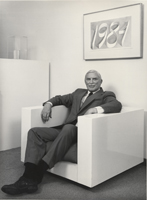
Henry T. Hopkins, courtesy SFMOMA
Former San Francisco Museum of Modern Art (SFMOMA) director Henry T. Hopkins passed away on September 27, 2009. During his twelve-year tenure (1974–86), Hopkins sought to establish SFMOMA as the West Coast’s premier museum of twentieth-century art through a deliberate plan of accelerated activity, determining new directions for both the exhibition program and the permanent collection and launching the museum on a course of renewed excitement and expansion.
“Hopkins’s leadership at SFMOMA was distinguished by outstanding intellect and creative vision,” says Neal Benezra, SFMOMA director. “In addition to organizing important exhibitions—including Ed Ruscha’s first museum show—he transformed the collection through acquisitions of major work by Philip Guston and Clyfford Still, and led the museum to the forefront of the international art community.”
Among Hopkins’s first accomplishments was to rename the institution as the San Francisco Museum of Modern Art in January 1976, adding the word “modern” to more accurately reflect the identity and mission already established during its earliest years. He also created more gallery space for the museum in its War Memorial Veterans Building, which SFMOMA was quickly outgrowing. In addition, the scope of the exhibition program was expanded to emphasize not only painting, sculpture, photography, and architecture and design, but also experimental forms related to performance and Conceptualism. Under Hopkins’s stewardship, the museum strengthened its commitment to experimental media with pioneering exhibitions such as Jim Melchert: Points of View: Slide Projection Pieces (1975), featuring Changing Walls (1971), which in 1973 became the first time-based media work acquired by SFMOMA.
At SFMOMA, Hopkins not only bolstered the quality of presentations brought in from outside institutions—including important exhibitions of work by Cy Twombly (1976), Robert Rauschenberg (1977), and George Segal (1979)—but also increased the pace and ambition of exhibitions organized internally. The enlargement of the curatorial staff and a renewed emphasis on exhibitions drawn from the museum’s own collection resulted in a record number of homegrown shows under Hopkins’s leadership. He instigated the first exhibition of Judy Chicago’s controversial The Dinner Party (1979), promising the artist that he would show the project if she ever finished it. Chicago held him to his word, and more than one hundred thousand visitors lined up at SFMOMA, waiting hours to see this now iconic feminist magnum opus.
Hopkins worked very closely with abstract and figurative expressionist Philip Guston to plan a pivotal retrospective of the artist’s work that opened to critical acclaim in January 1980 before embarking on an international tour. Says Kent Roberts, SFMOMA exhibition design manager, who served under Hopkins in the 1980s, “One of my fondest memories is working on Hopkins’s legendary Guston show, and being present in the galleries while he and the artist discussed the installation. As a curator, Hopkins was always engaged and highly approachable.”
Hopkins drew on his long friendship with Ed Ruscha to present The Works of Edward Ruscha, the artist’s first museum survey, in 1982, and also oversaw such important projects as SFMOMA’s inaugural biennial survey of contemporary American art Twenty American Artists (1980), featuring work by Christo, Jim Dine, and Lucas Samaras, among others; A German Intuition, 1905–1920 (1981), coorganized with the Solomon R. Guggenheim Museum; Edward Hopper: The Art and the Artist (1981); Kandinsky in Munich: 1896–1914 (1982); and Diego Rivera: The Cubist Years (1984).
The accelerated exhibition program under Hopkins’s tenure was paralleled by an equal intensification in collection activity. Hopkins may be best remembered for securing in 1975 Clyfford Still’s extraordinary gift of twenty-eight monumental canvases representing the entire span of his career, making SFMOMA the first public institution to own a substantial collection of the abstract pioneer’s work. The acquisition marked the onset of Hopkins’s strategy to collect concentrations of works by first-generation Abstract Expressionists with California connections. In addition, Hopkins’s approval of the purchase of Philip Guston’s monumental triptych Red Sea; The Swell; Blue Light in 1975 inspired the artist’s subsequent gift of four more paintings and a legacy of future gifts from trustees and patrons. Other acquisition highlights under Hopkins’s guidance include works by Josef Albers, Larry Bell, Roy De Forest, Richard Diebenkorn, Frank Stella, Donald Judd, Roy Robert Irwin, Agnes Martin, Joan Mitchell, and Andy Warhol.
SFMOMA’s photography program, which had been steadily active throughout the seventies, advanced significantly with Hopkins’s appointment of photography curator Van Deren Coke in 1979, followed by the official establishment of a Department of Photography in 1980, signaling the museum’s formal recognition of the importance of the medium. While SFMOMA had collected and exhibited photography since 1935, under Hopkins’s guidance, its photography holdings gained sharper focus through the addition of important concentrations of work by Robert Adams, Robert Frank, Robert Mapplethorpe, Man Ray, Edward Weston, and Joel-Peter Witkin, as well as landmark exhibitions such as the historical overview Avant-Garde Photography in Germany: 1919-1939, organized by SFMOMA in 1980 and subsequently circulated on a two-year international tour.
Similarly, Hopkins’s longstanding commitment to the discipline of architecture and design greatly increased the collection in this area and led to the 1983 founding of SFMOMA’s Department of Architecture and Design, the first such department on the West Coast.
Hopkins succeeded Gerald Nordland as the museum’s fourth director in February of 1974, after serving as head of the Fort Worth Art Center Museum (now the Modern Art Museum of Fort Worth). Prior to that, he held a seven-year post on the curatorial staff of the Los Angeles County Museum of Art. In 1986, after twelve years of leadership at SFMOMA, Hopkins departed to head the Frederick R. Weisman Art Foundation in Los Angeles, and would later become the first director of UCLA’s Hammer Museum. He was succeeded at SFMOMA by John R. Lane in 1987.